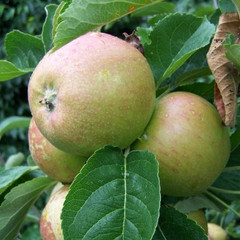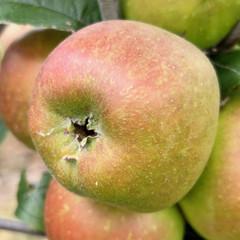Description
Introduced to the RHS by Robert Adams of Norfolk in 1826, although Hogg states that it is certainly a Herefordshire apple. Medium sized fruit that crops and keeps well, yellow gold fruit with an orange red flush and some slight russeting. Rich, aromatic 'nutty' flavour which was much prized by the Victorians. Makes a good espalier as it bears on tips and spurs. Being largely scab, mildew, and canker resistant: makes it very suited to organic culture.
"Its merit consists of being a very healthy hardy sort, a particularly free bearer, extremely handsome, by no means subject to speck or deformity, a good keeper and one of those rich fruits in which the proportions of sugar and acid are so intimately blended as to form the most perfect flavour of which the apple is susceptible."
Lindley, The Pomological Magazine, 1830
"The origins of this very epitome of a late dessert apple are given either as Norfolk, or Herefordshire. According to Hogg, the former origin was given because Mr Robert Adam, the donor of scions to the Horticultural Society of London in about 1826, had given them as 'Norfolk Pippin' because he had received them from Norfolk. But Dr Hogg was unequivocally convinced that it was a Herefordshire apple. At the invitation of its creators, he had become the technical editor of The Herefordshire Pomona (1885), the work of the Woolhope Naturalists' Field Club, and so was involved in collating the descriptions of many of the fruits they had found in the orchards of the region. In his Fruit Manual, he says 'I there found it exhibited in almost every collection as the Hanging Pearmain, and it is so widely grown across the county, that there cannot be any doubt that it is originally a Herefordshire apple'.
The Herefordshire Pomona itself baldly states that 'The history of this apple seems lost.' Whatever its origins, most author's are in full accord with Lindley's high regard of this cultivar, and many go on to praise the beauty of its pink flowers; some growers recommend it as a specimen for large pots. The York Backhouse Nursery catalogue of 1910 included it in its list of Select Dessert Cultivars, recommending it for market culture, and restricting its description of the quality to the single word ... 'Excellent'. It was indispensable in the traditional walled garden, as a lovely espalier perhaps, and the fruit was regarded as so handsome that it was in highest favour for table displays, '... a thing of beauty ... adding charm and colour ... before becoming a willing victim to the silver knife'. It fetched a high price at market, especially from Victorian fruiterers; so beautifully formed and coloured, it was an excellent subject for window displays.
To add to all these virtues, the bloom is noted to be fairly resistant to frost when in flower, so the tree is suitable for cool climates prone to late frost; its resistance to scab means that it also does well in higher rainfall regions in the UK and it thrives in most soil types; one must forgive a tendency to biennial bearing. The epithet 'pearmain', applied to pear-shaped apples, is thought to a be a contraction of Pyrus magnus." © Lin Hawthorne - 'The Northern Pomona'
For help with choosing the correct rootstock for your needs, please click here A Guide to Rootstocks
For help with choosing the correct size and shape, please click here A Guide to Fruit Tree Shapes








